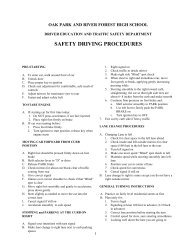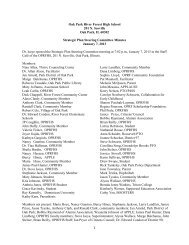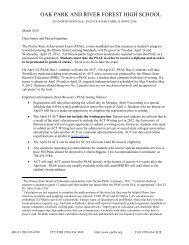Regulating the Cell Cycle â Notes 10.3
Regulating the Cell Cycle â Notes 10.3
Regulating the Cell Cycle â Notes 10.3
Create successful ePaper yourself
Turn your PDF publications into a flip-book with our unique Google optimized e-Paper software.
How fast do cells divide?<br />
• Muscle cells and nerve<br />
cells DO NOT DIVIDE<br />
AT ALL ONCE THEY<br />
HAVE DEVELOPED<br />
• Skin cells, cells in bone<br />
marrow that make blood<br />
cells, and cells of <strong>the</strong><br />
digestive tract DIVIDE<br />
RAPIDLY THROUGHOUT<br />
LIFE<br />
• These cells may pass<br />
through a complete cell<br />
cycle within a FEW<br />
HOURS
Controls of <strong>Cell</strong> Division<br />
• When cells are grown in <strong>the</strong> laboratory,<br />
most cells will DIVIDE UNTIL THEY<br />
COME INTO CONTACT WITH EACH<br />
OTHER<br />
• If cells are scraped away, <strong>the</strong> remaining<br />
cells BEGIN DIVIDING AGAIN<br />
• This also happens in <strong>the</strong> body when<br />
<strong>the</strong>re is a CUT IN THE SKIN OR<br />
BROKEN BONE
Cyclins<br />
• Cyclins are<br />
PROTEINS<br />
THAT<br />
REGULATE THE<br />
CELL CYCLE<br />
• First proteins to<br />
be discovered<br />
that regulate<br />
mitosis
Regulatory Proteins<br />
• Today we now know that <strong>the</strong><br />
cell cycle is REGULATED BY<br />
DOZENS OF REGULATORY<br />
PROTEINS BOTH INSIDE<br />
AND OUTSIDE OF THE<br />
CELL<br />
• INTERNAL REGULATORS<br />
respond to events that<br />
occur INSIDE THE CELL<br />
• Allow <strong>the</strong> cell cycle to<br />
continue only when<br />
certain events have<br />
occurred
Regulatory Proteins<br />
• EXTERNAL REGULATORS<br />
respond to events that<br />
occur OUTSIDE OF THE<br />
CELL<br />
• Direct cells to SPEED UP<br />
OR SLOW DOWN THE<br />
CELL CYCLE<br />
• GROWTH FACTORS<br />
stimulate <strong>the</strong> growth and<br />
division of cells<br />
• Important during<br />
EMBRYONIC<br />
DEVELOPMENT AND<br />
WOUND HEALING
<strong>Cell</strong> Death<br />
• Two ways for a cell to die:<br />
• DIE BY ACCIDENT DUE TO<br />
DAMAGE OR INJURY<br />
• “PROGRAMMED” TO DIE<br />
• The process of programmed cell<br />
death is called APOPTOSIS<br />
• Important because it plays a key role<br />
in development by SHAPING THE<br />
STRUCTURE OF TISSUES AND<br />
ORGANS<br />
• If too much Apoptosis occurs this<br />
can result in too much cell loss SEEN<br />
IN AIDS AND PARKINSON’S<br />
DISEASE
Cancer: Uncontrolled <strong>Cell</strong><br />
Growth<br />
• Cancer is A DISORDER IN WHICH BODY<br />
CELLS LOSE THE ABILITY TO CONTROL<br />
GROWTH<br />
• Occurs in MULTICELLULAR ORGANISMS<br />
• Cancer cells DO NOT RESPOND TO SIGNALS<br />
THAT REGULATE THE GROWTH OF MOST<br />
CELLS<br />
• <strong>Cell</strong>s grow UNCONTROLLABLY<br />
• This can form a mass of cells known as a TUMOR<br />
• BENIGN TUMOR – non cancerous<br />
• MALIGNANT TUMOR - cancerous
Cancer: Uncontrolled <strong>Cell</strong><br />
Growth<br />
• As cancer cells grow <strong>the</strong>y:<br />
• ABSORB NUTRIENTS<br />
needed by o<strong>the</strong>r cells<br />
• BLOCK NERVE<br />
CONNECTIONS<br />
• Prevent organs <strong>the</strong>y are<br />
invading FROM WORKING<br />
PROPERLY<br />
• Have <strong>the</strong> ability to spread<br />
throughout <strong>the</strong> entire body<br />
known as METASTISIZING
Causes of Cancer<br />
• Caused by DEFECTS IN GENES THAT REGULATE<br />
CELL GROWTH AND DIVISION<br />
• Common defect in gene called p53 which normally<br />
halts <strong>the</strong> cell cycle until all chromosomes are<br />
replicated<br />
• Defects caused by:<br />
• CARCINOGENS OR CANCER CAUSING AGENTS<br />
• Viruses (HPV)<br />
• Radioactivity<br />
• Ultraviolet light<br />
• Chemicals in cigarettes (arsenic, benzene, formaldehyde)<br />
• Asbestos
Detecting Cancer<br />
• Self exams<br />
• Biopsy: a sample of tissue is<br />
taken from <strong>the</strong> body and<br />
<strong>the</strong>n examined<br />
• X rays: example is<br />
mammograms<br />
• MRI: magnetic resonance<br />
imaging<br />
• Blood and DNA tests: can<br />
help determine <strong>the</strong><br />
likelihood of developing<br />
cancer
Cancer<br />
Treatments<br />
• Surgery – operation to remove<br />
some or all of tumor<br />
• Chemo<strong>the</strong>rapy – use of drugs to<br />
destroy cells that divide rapidly<br />
• Can kill healthy cells that divide<br />
rapidly<br />
• Side effects are nausea,<br />
fatigue, vomiting, and hair loss<br />
• Radiation <strong>the</strong>rapy – using a<br />
beam of radiation to shrink <strong>the</strong><br />
size of <strong>the</strong> tumor<br />
• Hormone <strong>the</strong>rapy?<br />
• Vaccine?
Preventing Cancer<br />
• Don’t smoke – tobacco is responsible for 30% of<br />
deaths due to cancer<br />
• Safeguard your skin – wear sunscreen even on<br />
cloudy days and don’t go in tanning beds<br />
• Eat your veggies and cut <strong>the</strong> fat – lots of fiber<br />
• Stay active and maintain a healthy weight –<br />
Prevents obesity, teens should get 60 min. daily<br />
• Get regular medical checkups

















